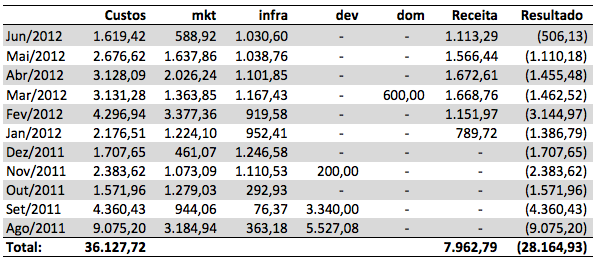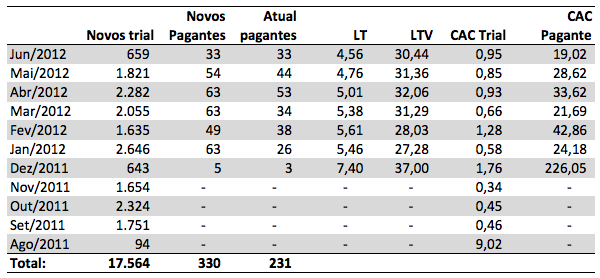This is a guest post from Joca Torres. Joca is the director of product development and product management at Locaweb, Brazil?s leader in web hosting, cloud servers and SaaS applications like email marketing and online stores, serving more than 250,000 customers. His first startup experience was in the early 1990s when he founded and ran one of the first Brazilian ISPs. He has been working with internet related software ever since.
Joca is also the author of The Startup Guide: how startups and established companies can create and manage profitable web products. The book is in Portuguese, but Joca has been kind enough to translate a few sections of it for us. Joca also posted all of the book?s content on the ?Guia da Startup? blog (in Portuguese).
?????????????????????????????????????????????
The conversion funnel explained in my previous post consists of a short term data set since within a few days or even hours, you can already see trends, draw conclusions, create hypotheses and validate these hypotheses, whether talking to your users, whether experimenting and measuring the results.
In addition to these short-term data, there are other data that take longer to stabilize and to show trends. The fact that they take longer to show trends doesn?t mean that you should not monitor them during the first months of your web product. These are the long-term numbers, which can be classified as global numbers (revenue and costs) and individual numbers (CAC, LT and LTV).
Global numbers: revenue and costs
Revenue is the money that you get when people use your product. There are some ways to obtain revenue from your web product:
- Revenue paid by the user: used by web products such as Google AdWords, MailChimp, Zendesk, Salesforce.com and others. In this case the revenue comes from periodic payment. Another quite common payment option is pay per use. Revenue paid by the user is more usual in B2B products. According to a tweet by Brian Walter, VP & Principal Analyst at Forrester for eCom & multichannel tech, only 7% of software revenue in the US comes from sales to consumers, 93% is from sales to businesses and the government. Some examples of web product with revenue paid by the final consumer are LinkedIn and ContaCal.
- Revenue paid by someone interested in your users: in this case someone who is interested in talking to your user pays you to do that. This model is widely used for web products used by consumers. Usually the business model is to sell advertising. One example is Google that allows anyone to use the search and charges companies to advertise in the search results. Another similar example is Facebook, which also offers free access to users and charges companies interested in doing advertising to Facebook users. Another source of revenue is selling usage reports to companies interested in knowing the behavior of your users. Note that in order to be interesting for someone to the point that this someone is willing to pay to access your user, you must have a very large amount of users who return often to use your product.
- Indirect Revenue:this is the revenue you get as a result of using the software, but that is not paid to use the software. There are basically two types of indirect revenue:
- Revenue from sale or rental of physical or virtual items: this is the case of online stores that use the web to sell or rent physical items. Amazon and Netflix are good examples. There are also stores that sell or rent virtual items such as Netflix streaming service or Amazon?s Kindle books. Note that e-commerce sites that are brokering the sale of physical items such as eBay are not of this kind. They are the type in which the revenue is paid by the user of the web product in a pay per use mode, since in this scenario the seller pays the broker site a commission on the sale.
- Cost Reduction: the case of internet banking, high school or college intranet, portal to access to results of clinical exams and other systems that do not sell anything or charge for access. In this type of product there is no revenue, but cost reduction. The internet banking reduces the cost of physical customer care. Intranet high school or college allows a faster flow of communication between school and student or student?s parents, saving on visits and meetings. Access to clinical exams results via the internet reduces costs of other forms of delivery of the test results, such as printing and mailing.
This revenue will be used to pay your costs. Once you are able to pay your monthly costs, the surplus will be used to offset the investment made during those months when the monthly income did not cover the monthly costs. Both revenues and costs should be checked every month. It?s a good idea to classify your costs in some categories to help you understand where you?re spending more and where you can save. I usually classify costs into four categories:
- Infrastructure: all costs necessary to keep the service running. In this category I include the cost of website hosting and application, domain registration, email marketing tools, SEO tools, A/B testing tools, online chat and so on. Usually the expenses are recurring and thus require much attention whenever you hire a new service in this category.
- development: here are all the costs to develop and implement new features on the website and the product, including programming, interface development, visual design and logo design. If you?re a developer, chances are you can save here.
- marketing: every investment that you do to attract customers, such as AdWords, Facebook ads, ads on websites, magazines, newspapers and TV. We must also include costs with printing and distribution of flyers, coupons, and brochures. At first you probably need investment here, but it is important to invest time in free ways to attract customers such as SEO, content generation and social recommendation.
- domain expertise: is the investment that you make to create and improve your product on its topic. For example, if you?re working on a web accounting product, it is important to have knowledge on this topic. If it?s a system for doctors, you have to know a bit of this world. In the case of ContaCal, I needed help from people who understand food and nutrition.
Obviously, to have a profitable product you need to have monthly revenue greater than the monthly costs. In ContaCal I?m still chasing that, but I?m getting closer to monthly profitability:

Here?s the translated column names in the same order they appear above:
- Costs
- marketing costs
- infrastructure costs
- development costs
- domain expertise costs
- Revenue
- Result
Individual numbers: CAC, LT and LTV
The revenue and cost are indicators of the overall health of your web product. However, it is important to have individual indicators, i.e., indicators by each customer. There are three individual indicators that are important:
- CAC: is the Customer Acquisition Cost. It is the sum of the costs associated with finding and getting the attention of potential customers, bringing them to your site, converting them to users of your product and later to a paid customers.
- LT: the lifetime of your customer, i.e., how long on average your customer stays your customer. This number only makes sense when you have a recurring revenue business model.
- LTV: is the lifetime value, the value of a customer for as long as she remains your customer. It?s the revenue generated by your customer during her LT.
From the above definitions it is easy to see that your product will be profitable when you have high LT and LTV and low CAC. What you need is an LTV greater than CAC. Something I?m working hard to get in ContaCal:

Here?s the translated column names in the same order they appear above:
- New trials
- New paying customers
- Remaining paying customers
- LT
- LTV
- Trial CAC
- Paying customer CAC
What you can see above is that LT is increasing, i.e., the oldest the customer, the greater is her LT. At the beginning of operations data change a lot, after a month in the life of your product LT can only be a maximum of one month or slightly more if you charge 3, 6 or 12 months in advance. However, it is important to monitor these indicators since the beginning of its operation. ContaCal has only six full months of operation as a fee based system. These data tend to stabilize at around 2 years of operation.
Next steps
Now that we discussed a bit about short and long-term numbers that give us some insight our web product, one question that everyone who starts a new venture has is how long does it take to start having results of this endeavor.
BUSINESS OF SOFTWARE ? FOR PEOPLE BUILDING GREAT SOFTWARE BUSINESSES.
#BoS2012 takes place over 2 and a half days 1st-3rd October, 2012, at the InterContinental Hotel, Boston.
?If you?re a serious software entrepreneur in any stage, it will change your life to attend Business of Software.? Jason Cohen, Smart Bear Software and WP Engine.
Speakers include Kathy Sierra, Professor Noam Wasserman, Dan Pink, Jason Cohen, Gail Goodman, Mikey Traft, Adii Pienaar, Joel Spolsky, Dan Lyons, Peldi, Paul Kenny, Noah Kagan, Bob Dorf, Dharmesh Shah and others who spend their lives at the sharp end of software businesses around the world. We hope you will be able to join us.
There is a $500 discount on the full ticket price till midnight PST 24th August. Ticket prices then rise by $100 every two weeks until 10 days prior to the event when they will be available, if we have not sold out, for the full price of $2,495. If you didn?t make it to last year?s event, you will also get access to all of the talks from BoS 2011 when you register for BoS 2012.
PLEASE DON?T FORGET TO BOOK ACCOMMODATION AT THE INTERCONTINENTAL HOTEL BY 27TH AUGUST TO SECURE THE CONFERENCE RATE.
Early Bird Registration Deadline midnight PST 24th August
Source: http://businessofsoftware.org/2012/08/keep-an-eye-on-the-long-term-numbers/
etan patz obama dog doug hutchison larry brown kevin hart thomas kinkade brewers
No comments:
Post a Comment
Note: Only a member of this blog may post a comment.